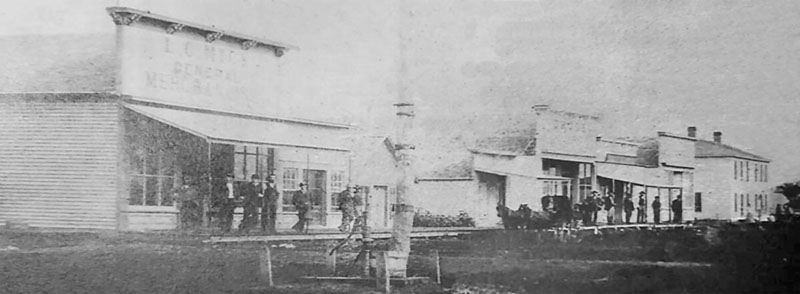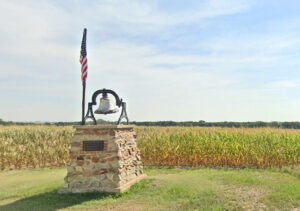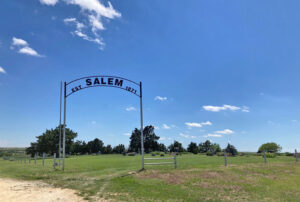
Salem, Kansas, 1880s.
Salem, Kansas, is an extinct town in White Mound Township of Jewell County. Located ten miles west of Burr Oak in the fertile White Rock Valley, it was an inland town in White Mound Township.
Menzo W. Smith was the first settler in the immediate neighborhood of Salem and, for a time, the farthest west settler in Jewell County or Northwestern Kansas. Later, he would serve as postmaster and justice of the peace at Salem.
A post office was opened in Salem on September 14, 1871, with George W.C. Smith as postmaster.
Salem was laid out on January 25, 1872, by H.L. Browning, C.P. Miller, and George W. Smith, the site taking a strip from each of their adjoining farms. The location was pleasant, and the surrounding country was fertile and thickly settled. The first building was built by Browning & Smith in March and occupied by Wilson Brothers of Scandia, with a stock of general merchandise. J.M. Parker opened The second store on June 1, 1872. That year, the Salem School District No. 2, the second school district in the county, was organized. In August 1872, the Jewell City Weekly Clarion mentioned that J.S. Miller and T.J. Burrow operated a Shingle Mill in Salem. The United Brethren congregation was organized that year under Elder Bird. The Free Methodists were organized that year by Reverend C.P. Miller, one of the Town Company.
The Methodist congregation was organized in 1877 with 15 members.
In 1880, the community held religious meetings in the district schoolhouse. Stagecoaches ran daily from Red Cloud, Nebraska, and Cawker City, Kansas. It had a saw and grist mill, two general stores, a hotel, a blacksmith, a hardware and agricultural implements dealer, a livery stable, a wagonmaker, a milliner, four physicians, a lawyer, and a justice of the peace, and a population of about 300. However, it was without a railroad.
By 1881, Salem also had real estate agents, a bathing establishment, a constable, a furniture store, a dealer in nursery stock, at least three grocery stores, a billiard hall, and a barber.
In 1882, J. Wilkes More, who had started a newspaper in Nelson, Nebraska in 1879, moved to Salem and established the Salem Chronicle. It was a seven-column folio with Greenback and Anti-Monopoly sentiment, which secured fair circulation. In May 1882, the Salem Chronicle reported that a Sunday School was organized with “much interest.” At that time, there were also United Brethren congregations, with J. McMillan serving as pastor.
A Methodist congregation was organized in May 1883, and a church was built in 1884.
Salem had a three-year high school from 1883 to 1888. Those years were the heyday of Salem’s existence. The population peaked at about 500, businesses expanded, and the area was prosperous.
But when the Central Branch of the Missouri Pacific Railroad “missed” Salem in 1887, it spelled the beginning of Salem’s demise. The district student census peaked at 134 students in 1888.
The school census dropped by 30 students the following year. There is no mention of a high school in Salem after the 1888-1889 school year.
Before long, houses and businesses were hauled and skidded southeast to Esbon and southwest to Lebanon in Smith County.
News items from 1887 to 1892 detail a continual exodus from Salem.
After its post office closed on December 31, 1903, mail was delivered rurally from Esbon.
By 1906, little was left in Salem. The Esbon Times of September 20, 1906, stated, “Salem, once one of the best and most prosperous towns in Jewell County, is no more.” The 40-acre townsite was reported as being sold for $50 an acre, and all that was left of the once flourishing town was the general store belonging to J. W. Ward & Son.
In 1910, Salem’s population had dropped to 51, and it received its mail by rural delivery from Esbon.
A new Methodist Church was built in 1920, which served the congregation until the few remaining members voted to dissolve on April 20, 1966. The church’s history spanned 83 years. A monument on 20 Road between V Avenue and V Road, just a mile from the Smith County line, memorializes the church. The Salem Cemetery also has a marker in memory of the church building. These are the only two remnants of the once-thriving community.
Salem was about ten miles west of Burr Oak on V Road.
©Kathy Alexander/Legends of Kansas, updated December 2025.
Also See:
Extinct Towns in Jewell County
Sources:
Blackmar, William; Kansas: A Cyclopedia of State History, Standard Publishing Co., Chicago, IL,1912.
Cutler, William; History of the State of Kansas, A.T. Andreas, Chicago, IL, 1883.
Jewell County Directories 1880, Kansas State Gazetteer and Business Directory, R. L. Polk & Company, Detroit, MI
Superior Express
Scarbrough, James A. and Winsor, M.; History of Jewell County, Kansas, Diamond Printing Office, Jewell City, Kansas, 1878.


